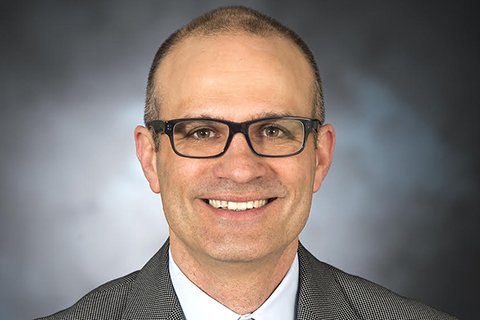CSE Professor Marc Hillmyer receives Entrepreneurial Researcher Award

University recognizes top inventors for entrepreneurial spirit
MINNEAPOLIS/ST. PAUL (03/29/2017) — University of Minnesota Chemistry Professor Marc Hillmyer received the Entrepreneurial Researcher Award at the University's Inventor Recognition Event for his pioneering research in developing environment-friendly materials from renewable sources. Hillmyer is one of four University researchers recognized for groundbreaking research and entrepreneurial spirit have led to new technologies that hold the potential to address major societal challenges.
Hillmyer's research focuses on developing biodegradable plastics made from renewable sources like sugar that can be used to make high-performance foam, rubber or hard materials. His discoveries also include materials that can filter viruses and bacteria from water, as well as materials that can remove salt from seawater. Hillmyer, along with two fellow plastics researchers, cofounded the startup Valerian Materials based on their advances. Hillmyer is also director of the National Science Foundation-funded Center for Sustainable Polymers,
Learn more about Hillmyer's research in this video.
The Inventor Recognition Event, presented by the University’s Office of the Vice President for Research and Office for Technology Commercialization, highlighted the recent achievements of University researchers and the breakthroughs that have resulted from their efforts. These innovations provide growth opportunities for businesses, benefit the public good and improve quality of life in Minnesota and beyond.
“Research and discovery already requires great talent and tireless work, but it takes still more to move innovations beyond the lab,” said Allen Levine, Ph.D., the U’s interim vice president for research. “We are truly fortunate to have so many researchers at the University whose ingenuity, creativity and perseverance are helping great ideas advance toward becoming a real-world solution.”
Other University researchers who received top awards included:
- Mikael Elias, College of Biological Sciences
Elias received the Early Innovator award for his work to develop enzymes that can fight harmful, antibiotic-resistant bacteria in a new, eco-friendly way. Elias’s technology “hijacks” the bacteria’s communication mechanism, which prevents them from forming the structures that lead to disease and drug resistance. His technology could help the 2 million people who contract antibiotic-resistant strains every year.
- Perry Hackett, College of Biological Sciences
Hackett received the Impact Award for developing the Sleeping Beauty Transposon System, a gene transfer platform that can be used to reprogram the human immune system to find and attack cancer cells. Up to 80 percent of people who receive therapies based on the technology experience disease remission or complete recovery. Last year, two biotech companies licensed a cancer treatment involving Sleeping Beauty to pharmaceutical company Merck for nearly $1 billion. The technology has also helped launch gene editing companies in other fields, such as agriculture, and has been used in basic research by thousands of researchers across the globe.
- Amy Hewitt, College of Education and Human Development
Hewitt received the Committee's Choice Award for leading the research, development and management of DirectCourse, an online training program for people who support individuals with developmental disabilities. The curriculum includes training programs focused on personal assistance, caregiving, recovery, and community inclusion. DirectCourse has had a broad impact, providing more than 11 million lessons to over 500,000 learners in 41 states and abroad.
This year’s event recognized 220 University inventors whose technology had been licensed or patented between July 2014 and June 2016. During those two years, researchers submitted more than 750 disclosures of new inventions to OTC and filed for nearly 350 patents to protect the intellectual property behind some of these inventions.
“I love to talk about our faculty’s research and inventions because it helps to drive the innovation culture of the entire state of Minnesota,” said University President Eric Kaler. “This creation of new knowledge, new processes and new products — of cures, treatments and solutions — is what a great public, land-grant research university like ours does every day, and it is work that is truly committed to the public good.”
For more information on the Inventor Recognition Event and to view videos about each Innovation Award winner, visit the Office of the Vice President for Research website.
